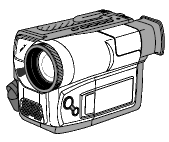
These cameras are now obsolete.
Camera and Editing Information
I used an analog Samsung SCL 906 camcorder (seen below).

These cameras are now obsolete.
Filming
I
used 3 of these same video cameras that I bought at a local discount store. I
purposely purchased analog cameras rather than digital cameras because this
analog camera would go 2 hours at a time without having to change the cassette.
Corky's meetings normally went about 2 hours at a time, give or take a few
minutes either way. I wanted as good quality as I could get. This particular
camera was less expensive than the others I was pricing at other local discount
stores. This one took Hi8 film that had 2 hours on each cassette. Later this
would cause me an extra step of transferring the film from the video camera
cassette to my DVD recorder on my tv, rather than running the cassette direct
onto my computer.
I
placed two of these cameras on tripods in 2 different areas of the room, the
main one facing directly on Corky, the other to my right, facing directly on
Corkyís sanctuary model. I have edited primarily from the main camera, but on
occasion I have used parts of the film on the sanctuary model where I needed it.
On occasion my main camera did not get all the audio or in one instance began to
get a lot of static. So I used the audio from the alternate camera. The main
audio was transmitted from a wireless mic on Corky that was then relayed to my
main camera by way of the audio receiver that I had connected to my camera.
Editing
I
searched on the Internet for an inexpensive editing program. After going through
a number of them, I finally found one called Power Director from Cyberlink. I
downloaded and tested it, and later purchased it. It was the only editing
program that would accept the formatted data that came off the DVD that I put
the studies onto. However, I found out later that the audio and video would
separate after a minute or two. I contacted Cyberlink and they suggested I
convert it into a specific format first (mpeg 2). I found a program that would
do this. I actually had to re-burn some of the film off the video cassettes onto
more DVDís because of technical issues in the conversion program. This time
the audio and video remained in sync. By request of a friend, I did a quick edit
of all the studies on the Sanctuary which resulted in my being able to have all
the studies done on audio first. That is why all the studies are done in audio
and not yet finished on video.
Results
As you can see by the
quality of the pictures, they are not digital quality. They look soft and at
times look like they are too soft. I think this occurred in the editing process
most likely when they were converted to the .mpeg2
format. I don't have any plans to digitalize the original studies on the
original cassettes and re-edit them. For the most part, the basic content is all
together and is reasonably good for both viewing as well as for listening.
You will notice that there are occasional changes in the audio in some spots.
Some places I patched sound almost hollow. I did some patch-in's from the 2nd
camera which only had a mic on the camera itself. It was difficult to match the
patched-in audio with the original audio. In some instances it came close to the
original audio, and in others it's very obvious that there is a change in the
audio from the patch.
Go to